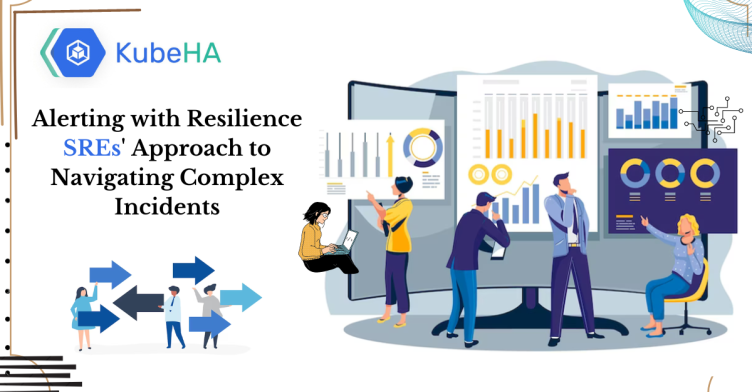
In the dynamic world of modern technology, Site Reliability Engineers (SREs) are the unsung heroes behind the scenes, ensuring the seamless operation of digital services. At the heart of their mission lies the art of navigating complex incidents with precision and speed. This article delves into the essential practice of alerting within the SRE domain, showcasing how their expertise in this crucial area revolutionizes incident response. By adopting resilient alerting practices, SREs not only detect and resolve incidents swiftly but also foster a culture of continuous improvement and unwavering reliability.
1. The Foundation of Resilient Alerting Systems:
Proactive Monitoring and Alerting:
SREs employ a proactive approach, monitoring key metrics and establishing precise alerting thresholds to detect anomalies before they escalate into critical incidents.
Automated Alert Correlation:
Leveraging advanced automation, SREs implement alert correlation techniques to reduce noise, ensuring that genuine incidents are prioritized and addressed promptly.
Diversified Alerting Channels:
Recognizing the importance of timely notifications, SREs utilize a multi-channel alerting approach, disseminating critical information via Slack, email, SMS, and dedicated incident management platforms.
2. Swift Response and Efficient Escalation:
Severity-Driven Escalation Protocols:
SRE teams define clear escalation policies based on incident severity, ensuring that the right expertise is engaged promptly, in alignment with the urgency of the situation.
Cross-Functional Collaboration:
SREs emphasize seamless communication and foster a shared incident command structure, promoting effective collaboration between teams during incident resolution.
Runbooks and Playbooks for Guided Response:
Equipped with pre-defined runbooks and playbooks, SREs follow structured procedures to address specific incidents, minimizing response time and mitigating human error.
3. The Art of Continuous Improvement:
Post-Incident Analysis and Root Cause Identification:
After each incident, SREs conduct thorough post-incident analyses to pinpoint root causes, evaluate the efficacy of their response, and extract invaluable lessons for future incident management.
Iterative Refinement of Alerting Mechanisms:
Through a feedback-driven approach, SREs continuously refine alerting thresholds and correlation mechanisms, fine-tuning their systems to minimize false positives and optimize response accuracy.
Incident Simulation Exercises:
Regularly simulating incidents empowers SREs to rehearse their response procedures, identify vulnerabilities, and elevate their incident management proficiency to unprecedented levels
In the realm of complex incident management, SREs stand as the vanguards of reliability, armed with resilient alerting systems and a proactive ethos. Their dedication to early detection, efficient response, and an unwavering commitment to improvement ensures the uninterrupted delivery of exceptional user experiences in an ever-evolving technological landscape. Alerting with resilience is not just a practice for SREs; it’s a pledge to uphold the highest standards of operational excellence in the digital realm. where uptime and performance are paramount, Site Reliability Engineers (SREs) have emerged as the linchpin of operational excellence. Their ability to navigate complex incidents with precision and speed is a testament to their expertise. One critical facet of this proficiency lies in the art of alerting. By fortifying alerting systems, SREs not only detect and respond to incidents swiftly but also foster a culture of resilience and continuous improvement. This article unveils the strategic approach SREs employ in their pursuit of unwavering reliability.
4. Building a Robust Alerting Infrastructure:
Proactive Monitoring for Early Detection:
SREs champion a proactive monitoring stance, setting up comprehensive checks to identify anomalies before they escalate into major incidents.
By leveraging sophisticated tooling, they establish alerting thresholds that provide early warning signs.
Smart Alert Correlation:
Automation is key. SREs implement intelligent alert correlation techniques to sift through the noise, allowing them to focus on actionable alerts.
Machine learning algorithms assist in recognizing patterns, grouping related alerts, and providing a clearer incident picture.
Diverse Notification Channels:
Recognizing the urgency of timely alerts, SREs deploy multi-channel notifications, ensuring that relevant stakeholders are reached via Slack, email, SMS, and specialized incident management platforms.
5. Incident Response Excellence:
Seamless Escalation Policies:
SRE teams define escalation hierarchies based on incident severity, guaranteeing that the right expertise is engaged at the right time.
Critical incidents trigger immediate responses, while lower severity incidents adhere to established protocols.
Collaborative Command Structure:
SREs understand that no one operates in isolation during an incident. They foster a culture of cross-team collaboration with clearly defined roles and responsibilities within an incident command structure.
Runbooks and Playbooks:
Pre-defined playbooks and runbooks serve as the backbone of incident response. They provide step-by-step guidance, allowing SREs to navigate through incident resolution with precision, speed, and accuracy.
6. The Cycle of Continuous Improvement:
Post-Incident Analysis and Learning:
After every incident, SREs conduct rigorous post-mortems. They dissect the incident, identifying root causes, evaluating the efficacy of responses, and deriving valuable lessons for the future.
Iterative Refinement of Alerting Logic:
SREs embrace a feedback-centric approach, perpetually fine-tuning alerting thresholds and correlation logic. This ongoing refinement reduces false positives and ensures that alerts are meaningful and actionable.
Simulated Incident Drills:
Practice makes perfect. SREs regularly engage in simulated incident exercises. These drills not only reinforce response procedures but also uncover potential weaknesses and polish incident management capabilities.
SREs are the vanguards of operational stability, and their mastery of alerting systems is a cornerstone of their success. Through early detection, swift response, and an unyielding dedication to refinement, they uphold the reliability of digital services in an ever-evolving landscape. Alerting with resilience is more than a practice for SREs; it’s a commitment to an uninterrupted, exceptional user experience in the face of any challenge. Follow KubeHA Linkedin Page KubeHA